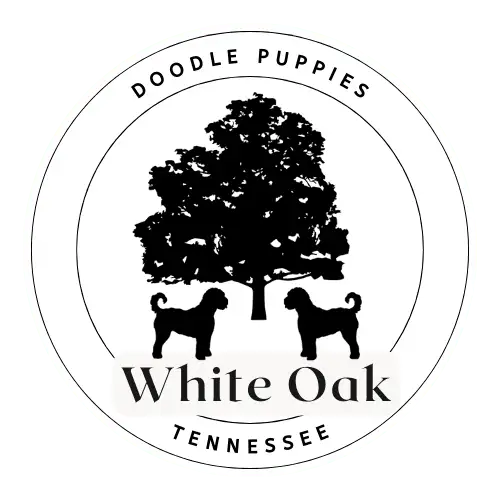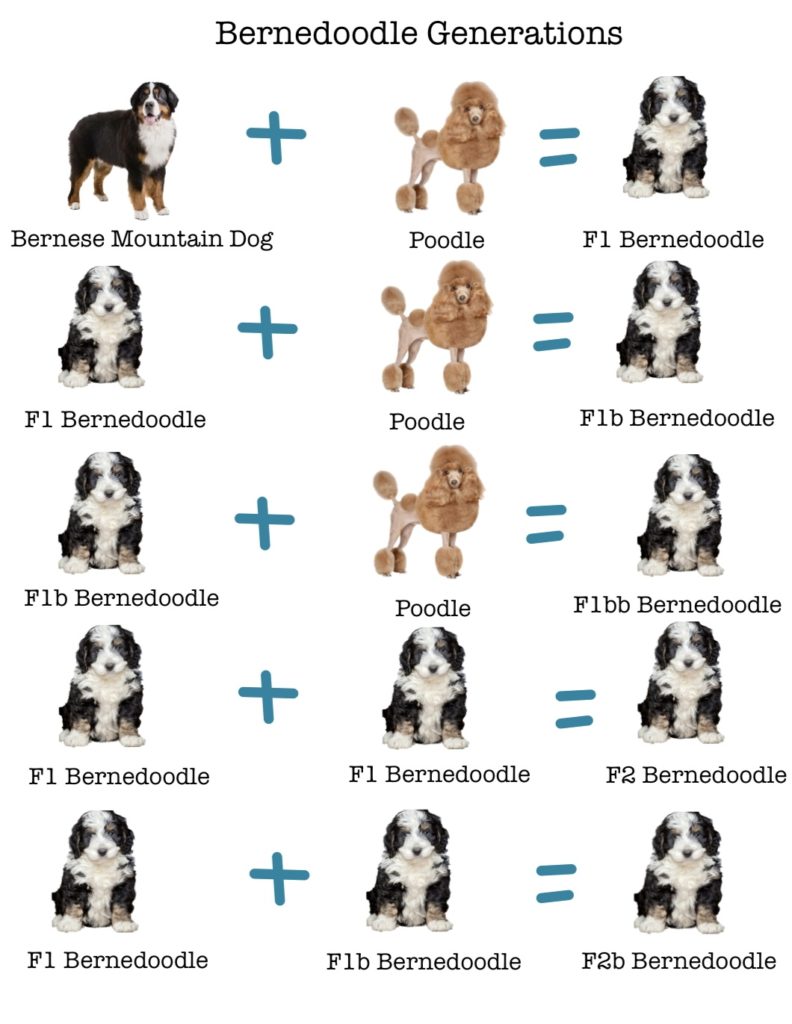- Tel: 423-534-1535
- charo@whiteoakbernedoodles.com
- Johnson City, Tennessee, United States

Menu

Bernedoodles come in various generations, each offering unique characteristics and traits. Understanding the differences between F1, F1B, F2, and multigen Bernedoodles can help you choose the perfect companion for your family. Here’s a detailed breakdown of each generation to guide you in making an informed decision.
Choosing the right Bernedoodle involves understanding the traits and characteristics of each generation. Whether you prefer an F1, F1B, F2, or multigen Bernedoodle, each has unique features influenced by its genetic makeup. Ensure your breeder is knowledgeable and uses DNA testing to accurately predict the traits of the puppies.
By knowing these differences, you can select a Bernedoodle that fits your family’s needs, ensuring a happy and healthy addition to your home!

ExcellentBased on 9 reviews Trustindex verifies that the original source of the review is Google.
Trustindex verifies that the original source of the review is Google. Michelle West2024-04-13Such a sweet family and little Gus is such a joy.Trustindex verifies that the original source of the review is Google.
Michelle West2024-04-13Such a sweet family and little Gus is such a joy.Trustindex verifies that the original source of the review is Google. Amy Pepin2024-04-08Charo was amazing and has done a great job raising these puppies! Our Sammy slept through the night in his crate the very first night and no potty mistakes yet! These are healthy well cared for puppies! Very smart too! I highly recommended Charo at White Oak Doodles as a breeder!😊👍🏽Trustindex verifies that the original source of the review is Google.
Amy Pepin2024-04-08Charo was amazing and has done a great job raising these puppies! Our Sammy slept through the night in his crate the very first night and no potty mistakes yet! These are healthy well cared for puppies! Very smart too! I highly recommended Charo at White Oak Doodles as a breeder!😊👍🏽Trustindex verifies that the original source of the review is Google. Patty Turner2024-04-08This is the second dog that I have adopted from Charo Harrison. The dogs that I have are very well-behaved and potty trained. You can tell the care and love the Charo puts in to the dogs that she breeds and is careful to ensure that they end up in a loving home.Trustindex verifies that the original source of the review is Google.
Patty Turner2024-04-08This is the second dog that I have adopted from Charo Harrison. The dogs that I have are very well-behaved and potty trained. You can tell the care and love the Charo puts in to the dogs that she breeds and is careful to ensure that they end up in a loving home.Trustindex verifies that the original source of the review is Google. Mike Burleson2024-04-03Thank you so much for our precious Larry. He has been the perfect addition to our family. He’s healthy, adorable and such a good boy. Next he’ll need a brother or sisterTrustindex verifies that the original source of the review is Google.
Mike Burleson2024-04-03Thank you so much for our precious Larry. He has been the perfect addition to our family. He’s healthy, adorable and such a good boy. Next he’ll need a brother or sisterTrustindex verifies that the original source of the review is Google. Scott Tutterow2024-04-02Our Famlies have gotten 2 puppies from White Oak in 2 different litters. This family of dog breeders is above and beyond. The puppies are very cared for with plenty of interaction with other animals and kids. Lots of love and care here in breeding. Health and character are top priority as well.Trustindex verifies that the original source of the review is Google.
Scott Tutterow2024-04-02Our Famlies have gotten 2 puppies from White Oak in 2 different litters. This family of dog breeders is above and beyond. The puppies are very cared for with plenty of interaction with other animals and kids. Lots of love and care here in breeding. Health and character are top priority as well.Trustindex verifies that the original source of the review is Google. Kelly Anderson2024-04-01White Oak Doodles has given us two beautiful puppies from two different litters. Both dogs were very well trained and cared for before they made their way into our forever home. We love White Oak!Trustindex verifies that the original source of the review is Google.
Kelly Anderson2024-04-01White Oak Doodles has given us two beautiful puppies from two different litters. Both dogs were very well trained and cared for before they made their way into our forever home. We love White Oak!Trustindex verifies that the original source of the review is Google. Amy Marie2024-03-30Great experience! Best place to get a puppy! Charo did all she can do to make a great dog before our puppy left for her new home! So thankful for all of her hard work.Trustindex verifies that the original source of the review is Google.
Amy Marie2024-03-30Great experience! Best place to get a puppy! Charo did all she can do to make a great dog before our puppy left for her new home! So thankful for all of her hard work.Trustindex verifies that the original source of the review is Google. Kala Niedermeier2024-03-29Charo did an amazing job raising my goldendoodle puppy. I had to drive my puppy home on an 11 hour car ride and she did wonderful the entire time in the car. The first night I brought her home she slept through the entire night and even whined to ask to go potty outside. This shows just how good of a job Charo does at starting the potty training process with her pups. Throughout the process she has been super helpful and has obviously put in the hard work and care to raise her puppies to be successful and happy in their forever homes. I woukd 100% recommend anyone interested in getting a dog to go to White Oak Doodles!Trustindex verifies that the original source of the review is Google.
Kala Niedermeier2024-03-29Charo did an amazing job raising my goldendoodle puppy. I had to drive my puppy home on an 11 hour car ride and she did wonderful the entire time in the car. The first night I brought her home she slept through the entire night and even whined to ask to go potty outside. This shows just how good of a job Charo does at starting the potty training process with her pups. Throughout the process she has been super helpful and has obviously put in the hard work and care to raise her puppies to be successful and happy in their forever homes. I woukd 100% recommend anyone interested in getting a dog to go to White Oak Doodles!Trustindex verifies that the original source of the review is Google. Thomas Leonard2023-02-19Great food and service
Thomas Leonard2023-02-19Great food and service


Location: Johnson City, Tennessee,
United States
Phone: 423-534-1535
Email: charo@whiteoakbernedoodles.com